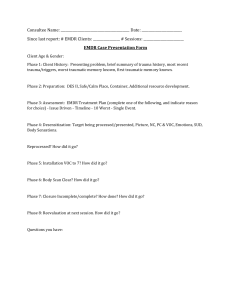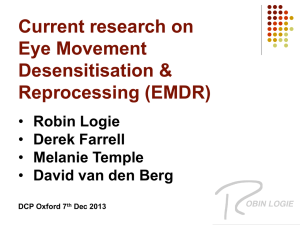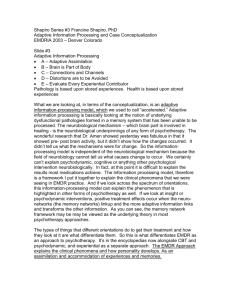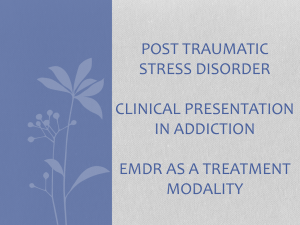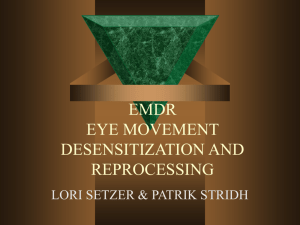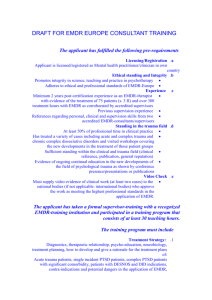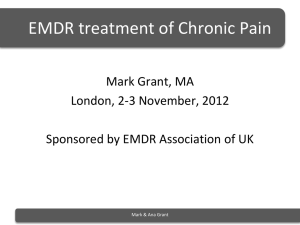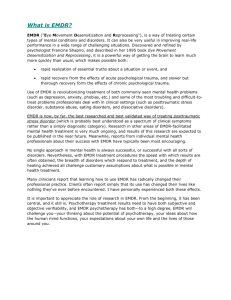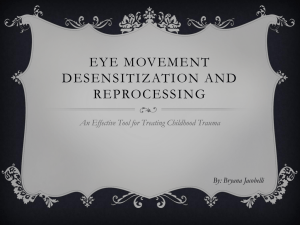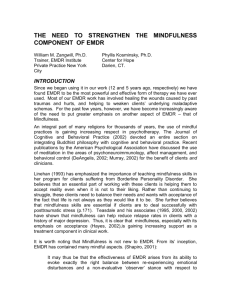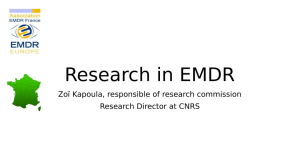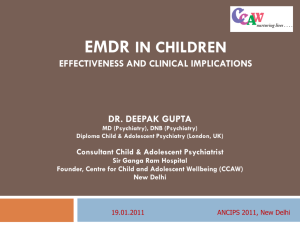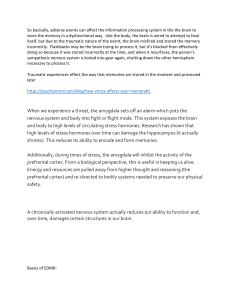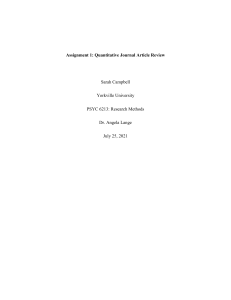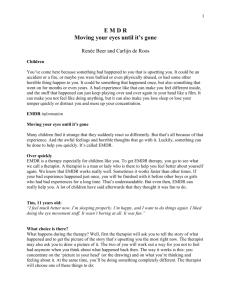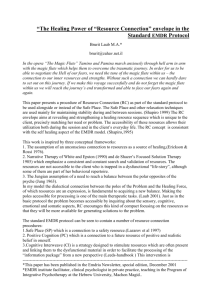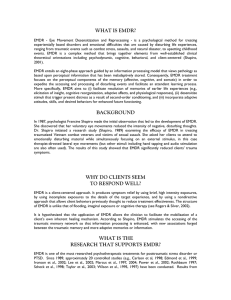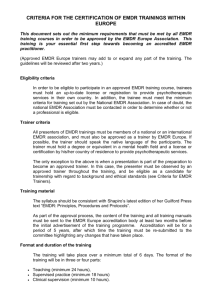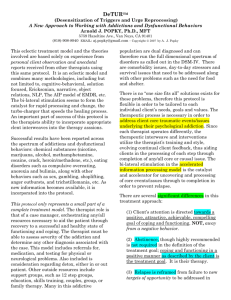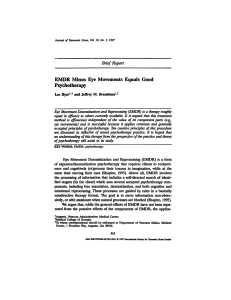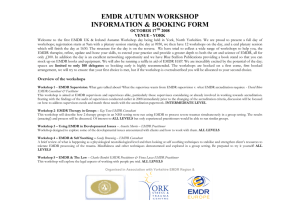emdr recent traumatic event (rte) protocol guidelines
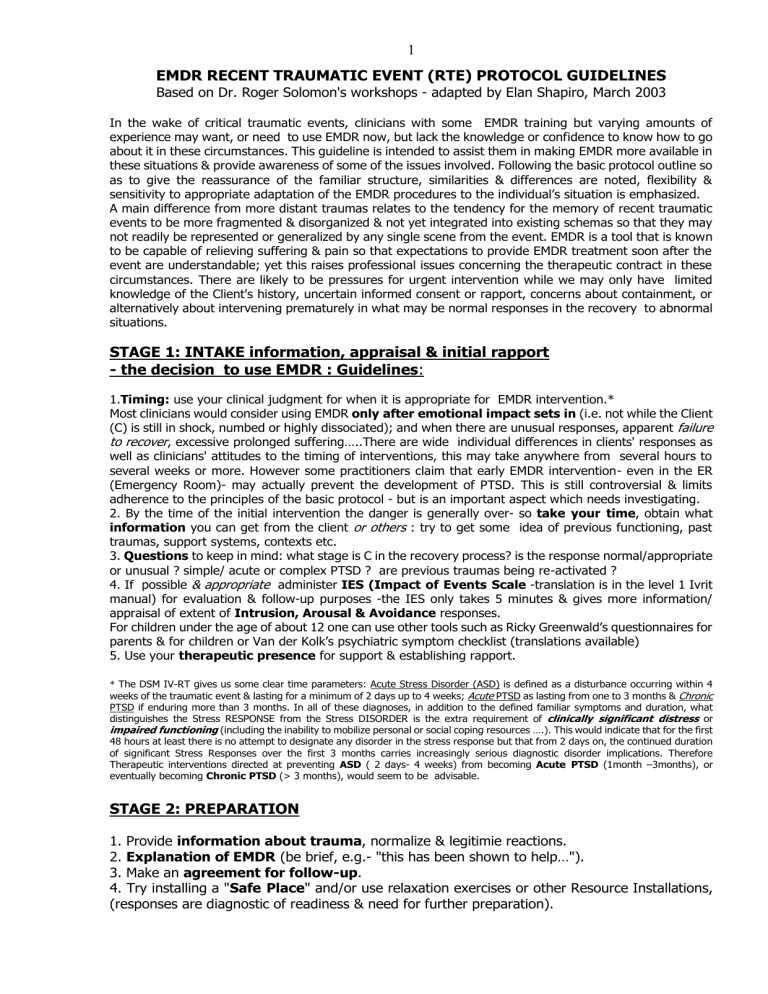
1
EMDR RECENT TRAUMATIC EVENT (RTE) PROTOCOL GUIDELINES
Based on Dr. Roger Solomon's workshops - adapted by Elan Shapiro, March 2003
In the wake of critical traumatic events, clinicians with some EMDR training but varying amounts of experience may want, or need to use EMDR now, but lack the knowledge or confidence to know how to go about it in these circumstances. This guideline is intended to assist them in making EMDR more available in these situations & provide awareness of some of the issues involved. Following the basic protocol outline so as to give the reassurance of the familiar structure, similarities & differences are noted, flexibility & sensitivity to appropriate adaptation of the EMDR procedures to the individual’s situation is emphasized.
A main difference from more distant traumas relates to the tendency for the memory of recent traumatic events to be more fragmented & disorganized & not yet integrated into existing schemas so that they may not readily be represented or generalized by any single scene from the event. EMDR is a tool that is known to be capable of relieving suffering & pain so that expectations to provide EMDR treatment soon after the event are understandable; yet this raises professional issues concerning the therapeutic contract in these circumstances. There are likely to be pressures for urgent intervention while we may only have limited knowledge of the Client's history, uncertain informed consent or rapport, concerns about containment, or alternatively about intervening prematurely in what may be normal responses in the recovery to abnormal situations.
STAGE 1: INTAKE information, appraisal & initial rapport
- the decision to use EMDR : Guidelines:
1.Timing: use your clinical judgment for when it is appropriate for EMDR intervention.*
Most clinicians would consider using EMDR only after emotional impact sets in (i.e. not while the Client
(C) is still in shock, numbed or highly dissociated); and when there are unusual responses, apparent failure to recover , excessive prolonged suffering…..There are wide individual differences in clients' responses as well as clinicians' attitudes to the timing of interventions, this may take anywhere from several hours to several weeks or more. However some practitioners claim that early EMDR intervention- even in the ER
(Emergency Room)- may actually prevent the development of PTSD. This is still controversial & limits adherence to the principles of the basic protocol - but is an important aspect which needs investigating.
2. By the time of the initial intervention the danger is generally over- so take your time, obtain what
information you can get from the client traumas, support systems, contexts etc.
3. Questions to keep in mind: what stage is C in the recovery process? is the response normal/appropriate or unusual ? simple/ acute or complex PTSD ? are previous traumas being re-activated ?
4. If possible & appropriate or others : try to get some idea of previous functioning, past
administer IES (Impact of Events Scale -translation is in the level 1 Ivrit manual) for evaluation & follow-up purposes -the IES only takes 5 minutes & gives more information/ appraisal of extent of Intrusion, Arousal & Avoidance responses.
For children under the age of about 12 one can use other tools such as Ricky Greenwald’s questionnaires for parents & for children or Van der Kolk’s psychiatric symptom checklist (translations available)
5. Use your therapeutic presence for support & establishing rapport.
*
The DSM IV-RT gives us some clear time parameters: Acute Stress Disorder (ASD) is defined as a disturbance occurring within 4 weeks of the traumatic event & lasting for a minimum of 2 days up to 4 weeks; Acute PTSD as lasting from one to 3 months & Chronic
PTSD if enduring more than 3 months. In all of these diagnoses, in addition to the defined familiar symptoms and duration, what distinguishes the Stress RESPONSE from the Stress DISORDER is the extra requirement of clinically significant distress or
impaired functioning (including the inability to mobilize personal or social coping resources ….). This would indicate that for the first
48 hours at least there is no attempt to designate any disorder in the stress response but that from 2 days on, the continued duration of significant Stress Responses over the first 3 months carries increasingly serious diagnostic disorder implications. Therefore
Therapeutic interventions directed at preventing ASD ( 2 days- 4 weeks) from becoming Acute PTSD (1month –3months), or eventually becoming Chronic PTSD (> 3 months), would seem to be advisable.
STAGE 2: PREPARATION
1. Provide information about trauma, normalize & legitimie reactions.
2. Explanation of EMDR (be brief, e.g.- "this has been shown to help…").
3. Make an agreement for follow-up.
4. Try installing a "Safe Place" and/or use relaxation exercises or other Resource Installations,
(responses are diagnostic of readiness & need for further preparation).
2
5. Use a Metaphor-to obtain distance & control
-e.g. viewing the event as a video on a TV screen
(enhance with the addition of distance / remote control /small screen /etc.).
STAGE 3: ASSESSMENT
& STAGE 4 DESENSITIZATION (PROCESSING the TRAUMA)
Ask C to tell the story- a narrative from the start until C felt safe(er) to go through a moment to moment description of what happened together with inner appraisal (including thoughts and reactions) to assist in organizing the experience and priming the processing. Be cautious about detailed description of gruesome details, assess for extent of dissociation and readiness to deal with intense affect. i)
TARGET & PROCESS: the most disturbing moment first**
-use as much of the full protocol as is appropriate.
-be aware of likely NC's & PC's & suggest them tentatively when necessary. While obtaining an NC/PC can help the client understand and contain the affect, there are times when there is "speechless" terror and words are unavailable. In these situations verbalization of an NC/PC may not be necessary or appropriate and correspondingly then no need for a VoC or for SUDs measures when the affect is evidently very high.
Typical NC-PC themes:
RESPONSIBILITY: NC: its my fault… I should have done something (else)..
I could have avoided it / PC: I did the best I could.. It was beyond my control...I am innocent
SAFETY: NC: I am vulnerable…unsafe…..in danger….I'm going to die…..
PC: I am safe….. I survived…..
CONTROL: NC: I am not in control…helpless / PC: I have some control...I have choices…Yes there are things I can't control -but I CAN (learn to) control how I respond.
SELF WORTH: NC: I am bad….I am inadequate….I am not good enough.
PC: I am a good person...I am okay as I am…the situation does not define my worth
THE EVENT: NC: It's not supposed to happen /PC: It can happen.
For the person who is experiencing fear, successful processing entails having the person feel safe in present ("I survived and its over"), and able to look at the future in an adult, rational manner
(" Bad things can happen but I can do the best I can in planning and dealing with the consequences"). ii)
TARGET & PROCESS other disturbing moments in chronological order (preferably) - again using as much of the full protocol as appropriate.** iii)
Ask C to visualize / go through / “review the whole video” sequence again with
eyes closed & pause (open eyes) at residual anxious moments then PROCESS.
Repeat until the entire event can be visualized with significantly reduced distress
(low observable or reported SUDs).
** with children (but not only) consider asking for a drawing or sketch for the target
STAGE 5 INSTALLATION
If not obtained previously select a spontaneous PC or ask for one now (if necessary suggest one tentatively- e.g. I survived…I am safe now) -obtain VoC if possible.
INSTALL PC together with visualizing the event from start to feeling safe
[PC + running the video].
RC (Resource Connections)
Identify moments of strength, resourcefulness, control, for installing & mental rehearsal for building self-efficacy & future templates.
STAGE 6 BODY SCAN
Don't forget - '' the body keeps the score''.
3
STAGE 7 STRONG DE-BRIEFING
Use Safe Place , relaxation &/or RC.
STAGE 8 FOLLOW-UP COMMITMENT
This is easily overlooked in emergency situations but should be stressed for responsible practice of EMDR.
=====================================================
